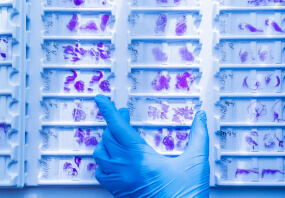General description
Existing proteasome activity-based fluorescent probes generally suffer from poor fluorescence and problems with selectivity.
TAS2 is a substrate-based fluorescent probe intended to be cleaved and released by the eukaryotic 20S core particle subunit of the proteasome to monitor proteasome activity. TAS2 demonstrates keen selectivity and resistance to nonspecific cleavage by proteases in human serum. The BioTracker™ TAS2 Proteasome Activity Probe can be used effectively in applications such as live cell assays, flow cytometry, or live-cell fluorescent microscopy.
MW=1407.12 g/mol
Probe is soluble in DMSO. Working final concentration of probe was 5 - 30 uM in appropriate growth media for 90 minutes.
SPECTRAL PROPERTIES
Excitation max λ: 496 nm
Emission max λ: 524 nm
Imaging was performed with a 488 nm excitation laser and emission window of 515-555 nm.
Zerfas BL, Coleman RW, Salazar-Chaparro AF, Macatangay NJ, Trader DJ. 2020. Fluorescent Probes with Unnatural Amino Acids to Monitor Proteasome Activity in Real-Time. ACS Chemical Biology. 15(9):2588–2596. doi:https://doi.org/10.1021/acschembio.0c00634.
Application
Purity: > 98% confirmed by HPLC. Structure confirmed by HNMR, LC-MS, and elemental analysis.
Features and Benefits
The BioTracker TAS2 Live Cell Probe exhibits strong fluorescence and is highly specific for proteasome activity in mammalian cells.
Target description
The proteasome, an elaborate protein complex that controls protein levels and important cellular pathways, is critical to eukaryotic cell function and homeostasis. The proteasome functions to degrade proteins that are damaged or no longer needed. The cell selectively shuttles these proteins to be broken into smaller peptide units that can be recycled and repurposed for other essential needs of the cell. The eukaryotic 26S proteasome is made up of two subunits, the 19S regulatory subunit and 20S core subunit. The proteasome acts by tagging proteins intended for degradation with a chain of ubiquitin which is recognized by the 19S regulatory subunit. After recognition, ubiquitin monomers are removed, and the remaining peptides are hydrolyzed by the 20S core subunit.
Improper proteasome function has been associated with a number of diseases including a variety of cancers. This makes the proteasome a high-interest target for further study and potential therapeutic development.
Physical form
Pale yellow solid.
Storage and Stability
Store BioTracker™ TAS2 Proteasome Activity Live Cell Probe at -20°C, desiccated and protected from lightNote: Centrifuge vial briefly to collect contents at bottom of vial before opening.
Other Notes
Live cell probe for detection of proteasome activity by fluorescence microscopy or flow cytometry. SCT235 is a valuable reagent for research of the function of proteasomes in health and in diseases, including cancer.
Legal Information
BioTracker is a trademark of Merck KGaA, Darmstadt, Germany
Disclaimer
Unless otherwise stated in our catalog or other company documentation accompanying the product(s), our products are intended for research use only and are not to be used for any other purpose, which includes but is not limited to, unauthorized commercial uses, in vitro diagnostic uses, ex vivo or in vivo therapeutic uses or any type of consumption or application to humans or animals.
- UPC:
- 51202805
- Condition:
- New
- Availability:
- 3-5 Days
- Weight:
- 1.00 Ounces
- HazmatClass:
- No
- MPN:
- SCT253












